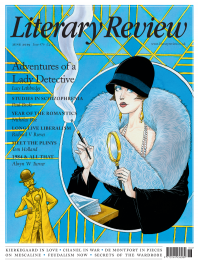George Wilson
Damage Report
What Red Was
By Rosie Price
Harvill Secker 296pp £12.99
Rosie Price’s debut novel is a complex examination of agency and sexual assault. At university, Kate becomes friends with Max Rippon and his family. The Rippons adore Kate and she is quickly included in every part of their lives, but this relationship is ruptured when Max’s cousin, Lewis, rapes her at a party. Kate suffers a mental breakdown and severe panic attacks. She eventually begins to open up by confiding in Max’s mother, Zara, but she leaves out the identity of her rapist, meaning that the Rippons struggle to understand or help. Kate’s resulting trauma is unbearable to read. Red – the colour of Lewis’s collar, which she concentrates on while the rape is taking place – becomes ‘the filter through which she apprehended everything’: a marker that drags her back to the horrific moment
of abuse.
What Red Was is unflinchingly visceral, but there are also tender moments of friendship and awkward family life beside the overwhelming damage. The novel includes the perspectives of all the Rippons in the wake of Max’s grandmother’s death. As the Rippons congregate for Christmas, they realise that Rupert, one of

Sign Up to our newsletter
Receive free articles, highlights from the archive, news, details of prizes, and much more.@Lit_Review
Follow Literary Review on Twitter
Twitter Feed
The son of a notorious con man, John le Carré turned deception into an art form. Does his archive unmask the author or merely prove how well he learned to disappear?
John Phipps explores.
John Phipps - Approach & Seduction
John Phipps: Approach & Seduction - John le Carré: Tradecraft; Tradecraft: Writers on John le Carré by Federico Varese (ed)
literaryreview.co.uk
Few writers have been so eagerly mythologised as Katherine Mansfield. The short, brilliant life, the doomed love affairs, the sickly genius have together blurred the woman behind the work.
Sophie Oliver looks to Mansfield's stories for answers.
Sophie Oliver - Restless Soul
Sophie Oliver: Restless Soul - Katherine Mansfield: A Hidden Life by Gerri Kimber
literaryreview.co.uk
Literary Review is seeking an editorial intern.